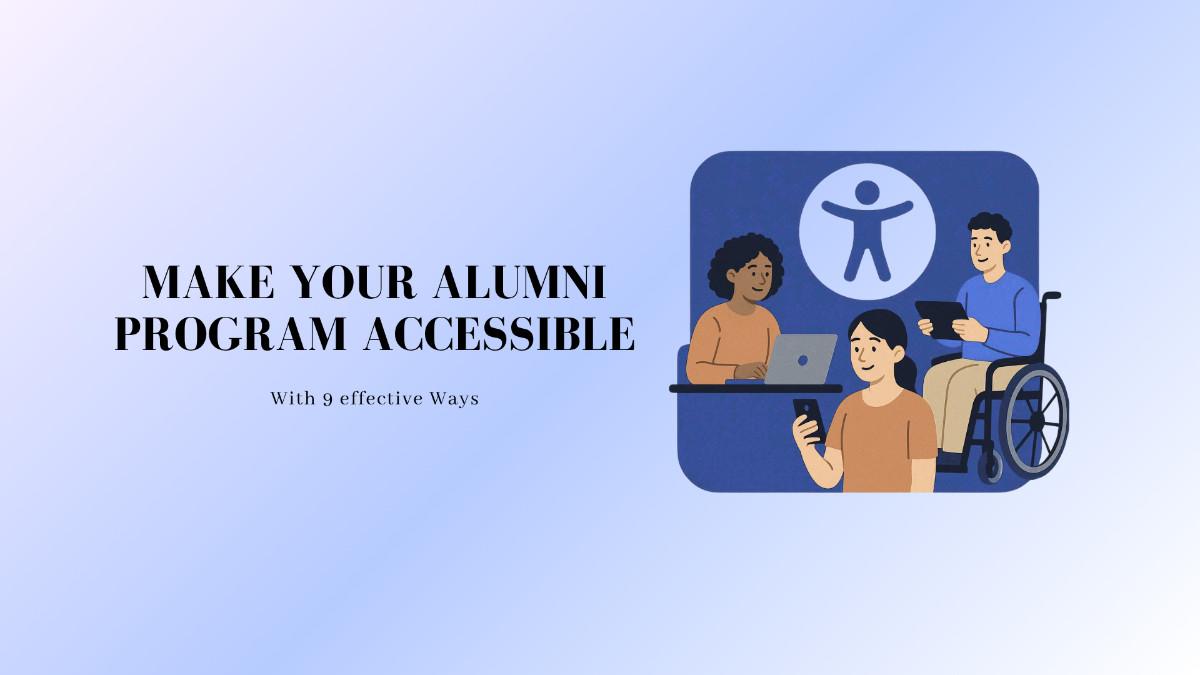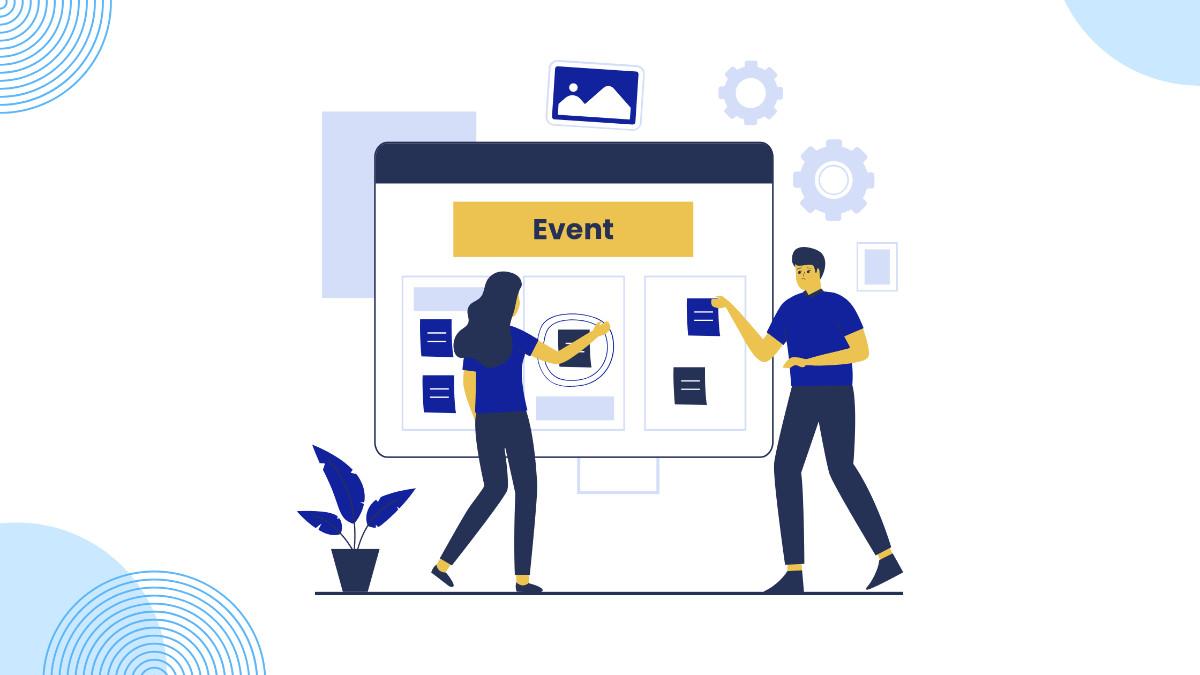9 Ways to Make Your Alumni Program Accessible
Explore 9 ways to make your alumni program more accessible. Improve engagement, inclusivity, and participation across your alumni network.

Are your alumni events not receiving the turnout you were hoping for?
Perhaps it’s time to consider the accessibility of your alumni program—and whether improving it could be the key to better alumni engagement. In Malaysia and beyond, staying connected with alumni can no longer rely solely on in-person meetups or printed newsletters. If you’re going to build a truly thriving alumni community, accessibility must be a priority—not an afterthought.
Before diving into the strategies, let’s take a quick look at what an alumni program really means and why it matters more than ever .
What Is an Alumni Program?
An alumni program is a structured initiative created by an organisation—be it a university, college, school, or company—to stay in touch with their former students or employees. These programs are often mutually beneficial, offering alumni access to exclusive resources, professional networks, and even perks like discounts, job boards, or mentoring opportunities.
Why Are Alumni Programs Important?
A well-run alumni program can play a vital role in the long-term success of any institution. For businesses, alumni programs drive brand advocacy, aid in talent acquisition, and nurture long-term partnerships. For educational institutions, they boost word-of-mouth marketing, enhance the institution’s reputation, and support fundraising initiatives.
From the alumni perspective, the motivation to stay connected often stems from a sense of loyalty or nostalgia. But that connection strengthens when programs offer meaningful engagement—like career growth, networking events, or even travel benefits.
In short, alumni programs benefit everyone involved—but they only work when they are designed with accessibility in mind. So how do you make yours easier to join, attend, and benefit from?
Let’s explore five tested, actionable steps to make your alumni program more inclusive and engaging in 2025 and beyond.
How to make your alumni program more accessible?
In today’s digitally connected world, alumni engagement can’t rely solely on physical meetups or printed newsletters. To build a strong, inclusive alumni community, accessibility must be a priority—not an afterthought.
But accessibility doesn’t just mean making things easier for people with disabilities (though that’s important). It also means removing everyday barriers that prevent alumni from staying involved—like lack of time, limited access to technology, language differences, or living far away from your institution.
When your alumni program is built to support different lifestyles, locations, and levels of digital comfort, you create space for more people to participate. And when it’s easier to stay connected, alumni are more likely to give back—with their time, mentorship, career support, or even contributions.
1. Offer Virtual Alumni Events That Anyone Can Attend
Why this matters
Geography is not an excuse anymore. Conducting alumni events online is one of the easiest and most effective methods of involving more individuals. From living in the next town over to the next continent, virtual platforms make it easy for them to attend without the expense or inconvenience of travel.
How this plays out in real life
- Virtual reunions: Employ video conferencing platforms to relive the campus cheer. Have breakout rooms for batch-mates or departments.
- Interactive webinars: Host distinguished faculty or alumni for panel discussions, fireside chats, or Q&As.
- Game nights and cultural showcases: Have a blast! Virtual campus tours, online trivia, or music nights captivate alumni on an emotional level.
How to enhance participation
- Employ event tools with calendar sync, timezone-convenient invites, and reminders.
- Record sessions for those unable to attend live and post them in a password-protected repository.
- Remind alumni through email, LinkedIn, WhatsApp groups, and mobile alerts.
The outcome?
Alumni stay engaged—even from halfway around the world.
2. Develop an Online Career Support Environment
Why it matters
Alumni engagement usually starts when there is a concrete advantage. Career growth is among the most powerful incentives for alumni to remain engaged. Still, most institutions continue using antiquated email-based platforms or static job postings.
Improve that experience with a dynamic, mobile-enabled career environment. This may involve:
- Alumni-to-alumni networking: Allow graduates to connect by industry, geography, or skill.
- Mentorship matching: Facilitate younger alumni to learn from experienced professionals.
- Job listings and internship boards: Curate the postings by alumni employers or hiring partners.
- Virtual career fairs: Host recruiter sessions or resume-building workshops online.
Why it works
Alumni are eager to give back—but many don’t know how. Giving them a systematic means of giving back or pursuing career opportunities keeps them involved in the long term.
Platform tip: Select a mobile-compatible solution so alumni can interact at any time, in any place.
3. Introduce and Promote an Alumni Business Directory
Why this is important
Your alumni community isn’t merely a network of support—it’s an opportunity marketplace. Numerous graduates have businesses or startups that could gain exposure, while others are willing to “shop alumni” and give back.
An online business directory creates pride and commerce in your community. It’s also an effective means of highlighting alumni success stories.
How to do it well
- Develop a searchable directory by industry, location, or services.
- Add contact information, business descriptions, logos, and alumni bios.
- Feature one business monthly in your alumni newsletter or social media channels.
- Invite alumni to share the directory in their networks.
Bonus idea: At holiday times, execute “Alumni Holiday Market” promotions showcasing alumni-owned products and services.
Impact
A business directory is advancing economic opportunities, forging more robust peer-to-peer connections, and highlighting the actual-world success of your institution’s graduates.
4. Offer On-Demand Learning and Development Resources
Why this matters
The desire to learn doesn’t stop at graduation. Many alumni want to upskill, switch careers, or explore new interests—but their schedules don’t always allow for live sessions or in-person classes.
By creating a resource library that’s accessible 24/7, you’re turning your institution into a lifelong learning partner.
Pro Tip:
If you’re part of your institution’s advancement or alumni relations team, and looking to improve your skills, you might consider the Alumni Relations Certificate Program offered by Connect Engage Thrive.
What to include in your resource library
- Recorded webinars with faculty or industry experts
- Micro-courses or short certification programs
- Alumni podcast series with career and leadership insights
- E-books, downloadable toolkits, or trend reports
Begin by inquiring
Survey your alumni to find out what subjects interest them most—AI, entrepreneurship, leadership, marketing, etc.—and craft your content accordingly.
How it generates engagement
Providing alumni with convenient access to topical, bite-sized learning enables them to develop personally and professionally. It also keeps your brand at the forefront of their minds as they connect your institution with lasting value.
5. Streamline Mentorship with Digital Matching and Flexibility
Why this matters
Mentorship is a frequently cited top way alumni get involved—but too many programs flounder because they’re difficult to administer or too inflexible.
By going online, your mentorship program can engage more alumni—when it’s convenient for them and from wherever they are in the world.
How digital mentorship succeeds
- Intelligent matching algorithms: Employ forms or AI tools to match mentees with mentors by interest, aspiration, and field.
- Self-scheduling tools: Allow participants to schedule calls or video chats without exchanging back-and-forth emails.
- Tracking progress: Informal goal-setting, check-ins, and milestone tracking to maintain momentum.
Ideas for growing your mentoring impact
- Introduce “Mentorship Months” where alumni can pledge short-term mentorship bursts.
- Celebrate top-performing mentors in alumni features or awards.
- Invite reverse mentoring among junior and senior alumni to encourage cross-generational growth.
Why it works
Alumni are more likely to engage when mentorship is convenient and fits into their lifestyle. Online mentoring opens the door for deeper, more meaningful connections—without the logistics getting in the way.
6. Account Access and Technical Barriers
Many alumni stop engaging when logging in becomes a chore. Some forget their credentials, others face device limitations. Reduce friction with:
- Passwordless login or guest access for event participation
- Single Sign-On (SSO) via LinkedIn or Google
- Mobile-first platform design that works on slower networks and older devices
This makes the program more approachable, especially for alumni who aren’t tech-savvy or live in lower-connectivity regions.
7. Language and Cultural Inclusion
In a multilingual country like Malaysia, accessibility must also account for language preferences. Alumni may speak English, Malay, Mandarin, or Tamil.
Improve accessibility by:
- Adding subtitles in Malay and English to recorded sessions
- Offering bilingual invites, surveys, or newsletters
- Enabling language filters in directories or mentorship modules
This ensures no alumni group feels excluded due to language alone.
8. Accessibility for People with Disabilities
While transcripts and captions help, accessibility must be embedded into your digital infrastructure.
Strengthen your design by:
- Ensuring WCAG (Web Content Accessibility Guidelines) compliance
- Using screen-reader-compatible layouts and clear navigation
- Providing high-contrast visuals and large, legible text options
These changes support alumni who are visually impaired, hard of hearing, or navigating your content via assistive technologies.
9. Visibility into Engagement and Inclusion
If you don’t measure accessibility, it’s difficult to improve it.
Build in basic tracking by:
- Monitoring participation data across devices, geographies, and age groups
- Tracking drop-off points in event sign-ups or portal usage
- Reviewing feedback to identify pain points in accessibility
With the right data, you’ll be able to continuously refine your approach—and make sure no alumni segment is left out.
Why Accessibility Is the Key to Alumni Success
When alumni engagement is convenient, relevant, and inclusive, your program thrives.
Here’s what accessible programs unlock:
- Greater event participation
- Improved volunteer signups and community contributions
- More robust job and mentorship networks
- Greater visibility for alumni businesses and initiatives
- Enhanced fundraising results over time
Accessibility doesn’t only enhance the alumni experience—it multiplies your institution’s impact.
The fact is, alumni do want to stay engaged. But if your program asks too much of them, delivers too little value, or only serves local participants, you’re accidentally shutting out many who’d love to give back.
By investing in accessibility—through technology, flexibility, and considerate design—you create a culture where every alumni feels seen, supported, and celebrated.
Making your alumni program accessible is the first step—building lasting relationships comes next.
Explore our blog on How to Build a Strong Alumni Network to learn how to turn alumni engagement into real, long-term impact.
Conclusion
Your alumni network is a living, breathing organism. And like any ecosystem, it will flourish when all the pieces are interconnected.
By 2025 and beyond, the question is no longer whether our alumni will participate—it’s:
“Have we made it easy enough for them to do so?”
If so, the outcomes will prove themselves.
Suggested Blogs
Let’s discuss the idea
Join hundreds of companies transforming their corporate communities with Almashines






